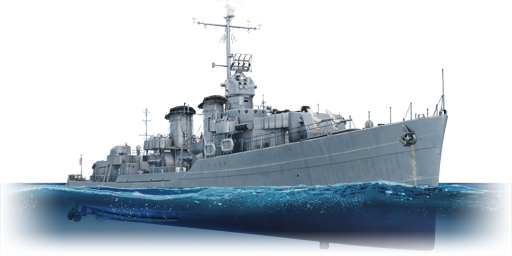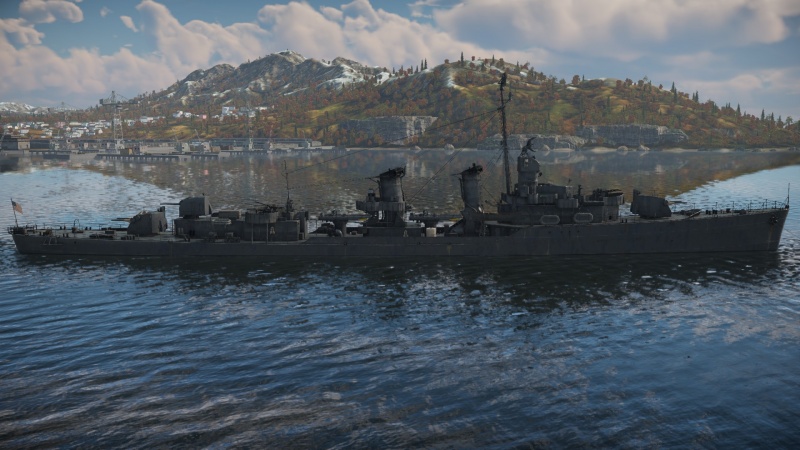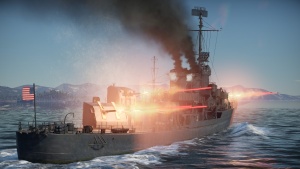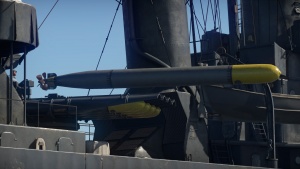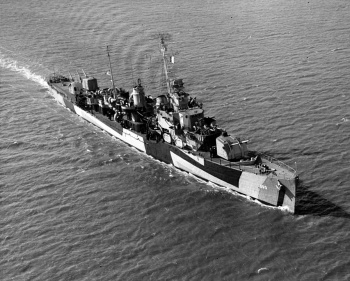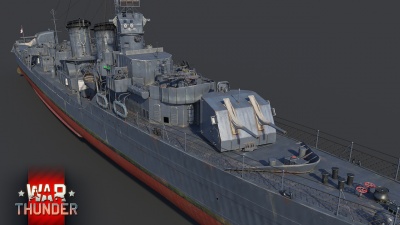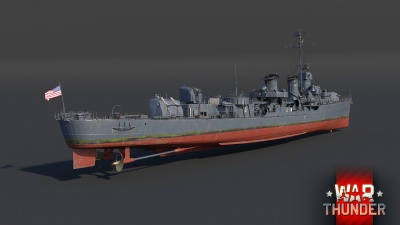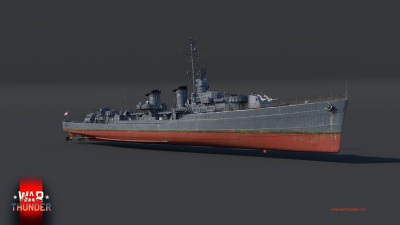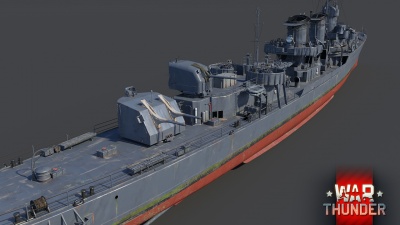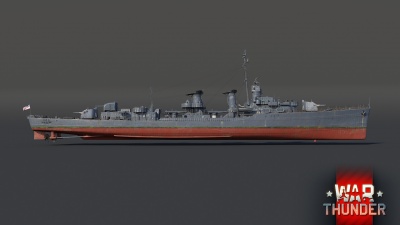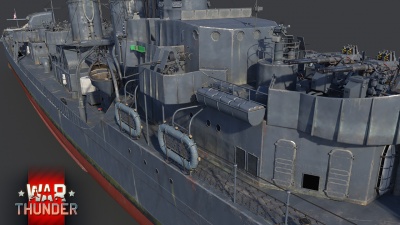USS Phelps
Contents
Description
The Porter-class, USS Phelps (DD-360), 1944 is a gift rank III American destroyer with a battle rating of 5.0 (AB/RB/SB). It was introduced during Update 1.95 "Northern Wind" as a reward for Season: Attack from the Sea.
General info
Survivability and armour
Talk about the vehicle's armour. Note the most well-defended and most vulnerable zones, e.g. the ammo magazine. Evaluate the composition of components and assemblies responsible for movement and manoeuvrability. Evaluate the survivability of the primary and secondary armaments separately. Don't forget to mention the size of the crew, which plays an important role in fleet mechanics. Save tips on preserving survivability for the "Usage in battles" section. If necessary, use a graphical template to show the most well-protected or most vulnerable points in the armour.
Mobility
Write about the ship's mobility. Evaluate its power and manoeuvrability, rudder rerouting speed, stopping speed at full tilt, with its maximum forward and reverse speed.
Modifications and economy
Armament
Primary armament
Phelps is equipped with five 5"/38 (12.7 cm) Mark 12 guns mounted in two dual and one single dual-purpose turrets - the dual turrets are mounted one fore and one aft while the single turret superfires over the aft dual turret. These guns are extremely effective against surface and air targets alike, and are capable of firing at an obscene 22 rounds per minute while using first-stage ammunition. The weapon also has a very good vertical and horizontal rotation speed, and is capable of engaging aircraft due to its high-angle capability (up to 85 degrees).
Phelps gets access to the standard three shell types - Mk.34 AAC, Mk.46 Common SP, and Mk.31 AAVT. The SP is typically the best pick for heavier-armoured targets such as cruisers, while the AAC shell works better against unarmoured targets due to its large explosive filler. The Mk.31 AAVT is a great option for dealing with air targets due to its proximity fuse - a single direct hit should be enough to destroy an incoming bomber.
Secondary armament
Phelps gets access to several 40 mm Bofors guns in dual and quad mounts. These weapons are extremely potent anti-aircraft guns due to their accuracy and punching power. Though these weapons fire slower than the 20 mm Oerlikon or 12.7 mm AN-M2, they more than make up for it due to their hard-hitting 40 mm shells. These guns are capable of shredding aircraft and small boats from ranges of 2.5 km away, though effectiveness will drop off after that range due to the large bullet drop. The guns fire from 4-round clips that reload continuously, meaning that they are capable of continuous fire. However, note that they will eventually jam after firing too long.
Anti-aircraft armament
Phelps rounds out its anti-aircraft armament with several 20 mm Oerlikon anti-aircraft guns. The 20 mm Oerlikon cannon was the standard light anti-aircraft gun for several nations, including the United States, and replaced the prior AN-M2 Browning machine gun. This weapon is an effective short-range AA gun, and has great firing angles. The guns can easily destroy any aircraft and torpedo boats who stray to close to Phelps. As well, the guns fire from a drum magazine that will need to be reloaded. Because of the magazine design, the gun will not jam with continuous fire.
Additional armament
Describe the available additional armaments of the ship: depth charges, mines, torpedoes. Talk about their positions, available ammunition and launch features such as dead zones of torpedoes. If there is no additional armament, remove this section.
Usage in battles
Describe the technique of using this ship, the characteristics of her use in a team and tips on strategy. Abstain from writing an entire guide – don't try to provide a single point of view, but give the reader food for thought. Talk about the most dangerous opponents for this vehicle and provide recommendations on fighting them. If necessary, note the specifics of playing with this vehicle in various modes (AB, RB, SB).
Pros and cons
Summarise and briefly evaluate the vehicle in terms of its characteristics and combat effectiveness. Mark its pros and cons in the bulleted list. Try not to use more than 6 points for each of the characteristics. Avoid using categorical definitions such as "bad", "good" and the like - use substitutions with softer forms such as "inadequate" and "effective".
Pros:
Cons:
History
USS Phelps (DD-360) was a destroyer leader of the Porter class. She was one of the most active American destroyers of the Second World War, earning 12 battle stars as the Flagship of Destroyer Squadron 1. Following her commissioning in 1936, she served in peacetime duties with the Pacific fleet, and was present at the Pearl Harbour Attack where she shot down an enemy plane. She then participated in the Battle of the Coral Sea, where she scuttled the abandoned carrier Lexington with five torpedoes. She served as an escort during the Battle of Midway, participated in the Marshall Islands campaign and spent the last part of the war as a convoy escort in the Atlantic. She was decommissioned and scrapped by 1947.[1]
Design and construction
The Phelps, named after Rear Admiral Thomas Stowell Phelps, was one of eight Porter-class destroyers used by the US Navy. The ships displaced 1,850 tons, exactly matching the 1,850-ton destroyer weight limitation of the London Naval Treaty. However, she typically displaced over 2,000 tons on combat missions and up to 2,663 tons full load. As a destroyer-leader, the Phelps carried eight 5-inch (127 mm) single-purpose guns on four twin turrets;[2] she was later refitted to carry two 5-inch dual-purpose twin turrets and a single five-inch DP turret at the rear. Her anti-aircraft armament was initially sparse, but was upgraded through the course of the war. Phelps also carried eight 533 mm torpedo tubes in two quad-mounts. She could make a top speed of 37 knots (69 km/h) and had a crew complement of 276.[2]
The Phelps was laid down on January 2nd 1934, and was launched on July 18th 1935. Following the completion of construction, she was commissioned on February 26th 1936.[1][2]
Operational history
After her commissioning, the Phelps escorted the cruisers Indianapolis and Chester with President Franklin D. Roosevelt to the Inter-American peace conference in Buenos Aires. She was then headquartered in the Pacific as the flagship of the First Destroyer Squadron. She was present at the Pearl Harbour attack and claimed one aircraft shot down. She was later assigned to escort Task Force 11, with the aircraft carrier Lexington, at the Battle of the Coral Sea. She also performed the less fortunate duty of finishing off the crippled Lexington using torpedoes after the carrier was hit by numerous Japanese bombs.[1][2]
Phelps served as an escort for the American carrier force at the Battle of Midway, where she took no damage. She participated in the landings at Guadalcanal and the ones at Attu, Alaska, where she provided gunfire support to invasion troops. She returned to the southern Pacific to serve as a gunship at the Marshall Islands campaign, where she bombarded Kwajalein and Eniwetok.[1] In June of 1944, she was part of the bombardment force at Saipan, shelling the island in preparation for American landings. In late 1944, she steamed through the Panama canal and served her final duty as a convoy escort in the Atlantic; she sailed three times with convoys bound for the Mediterranean. Following the War's end, she was decommissioned, and was scrapped in 1947. Phelps received 12 battle stars for her service during the war.[1][2]
Devblog
In the 1920’s, the USA acquired a pressing need to equip its fleet with so-called destroyer leaders, i.e. larger and better armed flagships for destroyer flotillas. At the time when the military was trying to convince the US government of the need for these vessels, and the government was arguing that the country already had sufficient numbers of standard destroyers, the London Naval Conference was held to discuss naval disarmament. The conference established an upper displacement limit of 1,850 tonnes for destroyer leaders, which prompted the development of a new ship that would conform to this new international military standard. A preliminary design for the new command ship was ready by November 1930. After almost 18 months of consultations and negotiations, the final design was approved. With a displacement of 1,850 tonnes, the ship carried eight 127mm guns, two quadruple 28mm guns (“Chicago pianos”), 2x4 torpedo launchers and light half-inch armour. All eight of the planned Porter-class destroyers were built and brought into service by 1937.
The realities of war revealed several defects in the new leaders, the most significant one was their extremely weak anti-air defence. The ship’s 127mm guns were not universal, and the power of the two “Chicago pianos” was woefully inadequate for defending the ship against aircraft attacks. The Porter-class ships underwent two major modernizations intended to enhance the leaders’ firepower. By 1944, the ships were markedly different. First of all, the outdated primary guns were replaced with all-purpose weapons, and their number was reduced to five in three turrets. The ship gained a formidable anti-air battery – one quadruple and two twinned 40mm Bofors guns, six 20mm Oerlikons, and high-calibre machine guns. Looking beyond armament, the ship’s decks were also transformed: the bridge was changed, the height of the rear superstructure was reduced, and reserve torpedoes were removed. Porter-class ships served in this form until they were decommissioned in the early post-war period.
Media
ImagesSee also
Links to articles on the War Thunder Wiki that you think will be useful for the reader, for example:
- reference to the series of the ship;
- links to approximate analogues of other nations and research trees.
External links
References
Works Cited
- Destroyer History Foundation. (2000). USS Phelps, DD 360. Retrieved November 19, 2020, from http://www.destroyerhistory.org/goldplater/ussphelps/
- Willishaw, F. (1996). USS PHELPS (DD-360). Retrieved November 19, 2020, from http://www.navsource.org/archives/05/360.htm
| Bethlehem Steel Corporation | |
|---|---|
| Gun Destroyers (DD) | |
| Porter-class | USS Phelps · USS Moffett |
| Fletcher-class | USS Cowell |
| Destroyer Leaders (DL) | |
| Mitscher-class | USS Wilkinson |
| Cruiser, Light (CL) | |
| Omaha-class | USS Raleigh · USS Detroit |
| Heavy Cruisers (CA) | |
| Northampton-class | USS Northampton |
| Portland-class | USS Portland |
| Baltimore-class | USS Baltimore · USS Pittsburgh |
| Des Moines-class | USS Des Moines |
| USA destroyers | |
|---|---|
| Clemson-class | USS Welborn C. Wood · USS Barker · USS Litchfield |
| Farragut-class | USS Aylwin |
| Porter-class | USS Porter · USS Phelps · USS Moffett |
| Somers-class | USS Somers · USS Davis |
| Fletcher-class | USS Fletcher · USS Bennion · USS Cowell |
| Allen M. Sumner-class | USS Sumner |
| Gearing-class | USS Gearing · USS Frank Knox |
| Mitscher-class | USS Mitscher · USS Wilkinson |
| USA premium ships | |
|---|---|
| Motor torpedo boats | PT-3 · PT-109 · PT-174 · Thunderbolt (PT-556) · PT-658 · PT-811 |
| Motor gun boats | LCM(6) Zippo · USS Douglas |
| Sub-chasers | Carmi (PC-466) |
| Destroyers | USS Welborn C. Wood · USS Wilkinson · USS Bennion · USS Cowell · USS Davis · USS Moffett · USS Phelps · USS Frank Knox |
| Light cruisers | USS Detroit · USS Helena |
| Heavy cruisers | USS Des Moines |
| Battleships | USS Arkansas |


